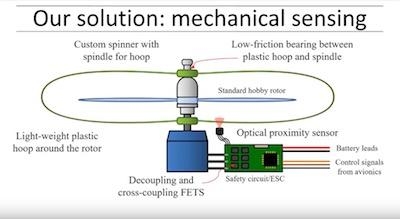Wed, Jun 06, 2018
Senses Proximity Of Biological Material To The Blades
Researchers at the University of Queensland in Australia are developing a sensor system that is designed to stop a spinning drone rotor blade before it can cause an injury.

The "Safety Rotor" is a cage around the rotor that spins more slowly than the propeller, and if a biological material is detected, stops the rotor within 0.077 seconds.
IEEE reports on its Spectrum website that the system consists of a plastic hoop that would touch any object, such as a finger, before it is contacted by the rotor blade. The hoops are spun passively by friction against the rotor hub and studded with IR reflectors that interface with an IR detector mounted near the rotor hub. If the IR signal is interrupted, it engages the rotor brake.
The system is expected to cost about $14 and weigh under 22 grams, so drone performance would not be impacted significantly.
According to the researchers:
"The measured latency [of the Safety Rotor’s braking response] was 0.0118 seconds from the triggering event to start of rotor deceleration. The rotor required a further 0.0474 s to come to a complete stop. Ninety percent of the rotational kinetic energy of the rotor (as computed from angular velocity) was dissipated within 0.0216 s of triggering, and 99 percent of the rotational kinetic energy of the rotor was dissipated within 0.032 s.
"The safety functionality of the safety system was tested on the bench using a processed meat “finger” proxy to trigger the hoop, and also applied to an open rotor (without hoop) for comparison. The rotor was spun at hover speed (1100 rads−1) and the finger proxy was introduced into the hoop at 0.36 ms−1 … The rotor and finger motion were captured using a shutter speed of 480 Hz. The rotor came to a stop within 0.077 s, with only light marks on the finger proxy from the impact of the hoop. The rotor was completely stopped by the time the finger reached the rotor plane. In contrast, the tip of the finger proxy introduced to an open rotor was completely destroyed."
(Image from University of Queensland YouTube video)
More News
Airport Rotating Beacon A visual NAVAID operated at many airports. At civil airports, alternating white and green flashes indicate the location of the airport. At military airports>[...]
Aero Linx: Fly for the Culture Fly For the Culture, Inc. is a 501(c)(3) non-profit organization that serves young people interested in pursuing professions in the aviation industry>[...]
Klyde Is Having Some Issues Comprehending The Fed's Priorities FMI: www.klydemorris.com>[...]
Also: Viasat-uAvionix, UL94 Fuel Investigation, AF Materiel Command, NTSB Safety Alert Norges Luftsportforbund chose Aura Aero's little 2-seater in electric trim for their next gli>[...]
Also: EP Systems' Battery, Boeing SAF, Repeat TBM 960 Order, Japan Coast Guard H225 Buy Despite nearly 100 complaints totaling millions of dollars of potential fraud, combined with>[...]
 ANN's Daily Aero-Term (04.25.24): Airport Rotating Beacon
ANN's Daily Aero-Term (04.25.24): Airport Rotating Beacon ANN's Daily Aero-Linx (04.25.24)
ANN's Daily Aero-Linx (04.25.24) Klyde Morris (04.22.24)
Klyde Morris (04.22.24) Airborne 04.24.24: INTEGRAL E, Elixir USA, M700 RVSM
Airborne 04.24.24: INTEGRAL E, Elixir USA, M700 RVSM Airborne 04.22.24: Rotor X Worsens, Airport Fees 4 FNB?, USMC Drone Pilot
Airborne 04.22.24: Rotor X Worsens, Airport Fees 4 FNB?, USMC Drone Pilot



